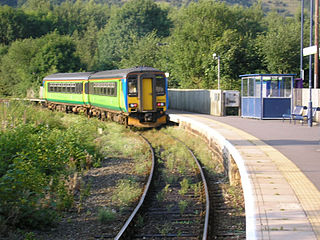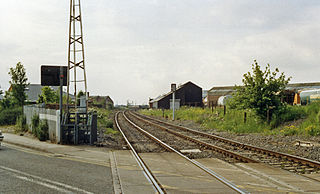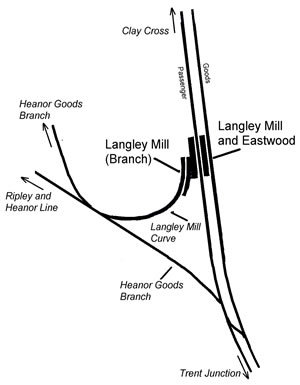
The West Somerset Railway (WSR) is a 22.75-mile (36.6 km) heritage railway line in Somerset, England. The freehold of the line and stations is owned by Somerset Council. The railway is leased to and operated by West Somerset Railway plc, which is supported and minority-owned by the West Somerset Railway Association (WSRA) charitable trust and the West Somerset Railway Heritage Trust (WSRHT). WSR operates services using both heritage steam and diesel trains.

The Ecclesbourne Valley Railway is a 9-mile (14.5 km) long heritage railway based at Wirksworth station in Derbyshire. It runs services to Duffield and along a short branch to Ravenstor.

The Midland Railway – Butterley is a heritage railway and museum complex at Butterley, near Ripley in Derbyshire.

Ambergate railway station serves the village of Ambergate in Derbyshire, England. It is located on the Derwent Valley Line, which connects Derby and Matlock; it diverges from the Midland Main Line just south of the station at Ambergate Junction. The station owned by Network Rail and managed by East Midlands Railway.

The Belmont railway line is an abandoned coal haulage and passenger rail line from Adamstown, New South Wales to Belmont, New South Wales. This was a private railway, being the property of the New Redhead Estate and Coal Company and was generally known as the Belmont Branch. The line closed in December 1991. It has since been converted into a cycleway or rail trail - The Fernleigh Track.

Woodhouse railway station serves Woodhouse and Woodhouse Mill in Sheffield, South Yorkshire, England. The station is 5.25 miles (8 km) east of Sheffield station on the Sheffield to Lincoln Line.

Drem railway station serves the small village of Drem in East Lothian, 5 miles (8 km) from the seaside town of North Berwick in Scotland. It is located on the East Coast Main Line (ECML) 18 miles (29 km) east of Edinburgh Waverley. Passenger services are provided on the ScotRail North Berwick Line, and the junction where the North Berwick branch diverges from the ECML is a short distance to the east of the station.

Bury Bolton Street railway station is a heritage railway station in Bury, Greater Manchester, England. Located on the East Lancashire Railway.
The Erewash Valley Line is a railway line in England, running from Long Eaton, between Nottingham and Derby, and Clay Cross, near Chesterfield. The southern part was opened by the Midland Railway in 1847 as far as Codnor Park, where it connected to established ironworks, and soon after, a line to Pinxton and Mansfield.

Stogumber railway station is a station in Kingswood, Somerset, England which serves the nearby village of Stogumber. It was opened by the West Somerset Railway in 1862 and closed by British Rail early in 1971. It was subsequently reopened in 1978 by the West Somerset Railway, a heritage line. It has a different layout to most stations, in that the main building lies on the opposite side of the tracks to the platform.
John Brown's railway was a line constructed in the Rotherham area of South Yorkshire, England, in order to link Silverwood Colliery to staithes situated alongside the River Don. The line, along with the collieries, became the sole property of John Brown & Company of Sheffield, in 1910, giving the line its local name.
There are 22 disused railway stations on the Bristol to Exeter line between Bristol Temple Meads and Exeter St Davids. The line was completed in 1844 at which time the temporary terminus at Beambridge was closed. The most recent closure was Tiverton Junction which was replaced by a new station} on a different site in 1986. 12 of the disused stations have structures that can still be seen from passing trains.
There are eight disused railway stations between Wadebridge and Bodmin North on the former Bodmin and Wadebridge Railway in Cornwall, in the United Kingdom, with ten other closed sidings on the branches to Ruthern Bridge and Wenfordbridge. The section from Boscarne Junction to Bodmin General is currently part of the Bodmin and Wenford Steam Railway; the line from Wadebridge to Wenfordbridge is now part of the Camel Trail, and the line to Ruthern Bridge can be followed for much of its length as it runs parallel to a public road.

The Leicester–Burton upon Trent line is a freight-only railway line in England linking the Midland Main Line near Leicester to the Derby to Birmingham line at Burton upon Trent. The line was built by the Midland Railway, which had acquired the Leicester and Swannington Railway in 1847, improving it and extending it. It opened throughout in 1849. The line connected an exceptional number of collieries and industrial premises, and several industrial branch lines were built radiating from it. Swadlincote was already an established community engaged in industry and there was a complex of branch lines there. The passenger service on the line was discontinued in 1964, and much of the mining-based industry has closed down; quarrying is the dominant residual originating traffic. There are proposals to reopen the passenger service, and these are under review at present (2022).

Butterley railway station is a preserved railway station on the Heritage Midland Railway - Butterley in Derbyshire.

Hammersmith railway station is a heritage railway station on the Midland Railway – Butterley in Derbyshire.

The Ambergate–Pye Bridge line is a partially opened and closed railway line in Derbyshire, England. It was a short east–west line linking the Midland Main Line with the Erewash Valley line. The line was opened by the Midland Railway to freight on 1 February 1875, and to passenger trains on 1 May 1875. The Midland was grouped into the London, Midland and Scottish Railway (LMS) in 1923.

Langley Mill railway station was a railway station which served the village of Langley Mill in Derbyshire, England. It was opened in 1895 by the Midland Railway on its branch between Heanor Junction on the Erewash Valley Line and Ripley.
The Brynmawr and Blaenavon Railway was a railway line in South Wales, within the historic boundaries of Brecknockshire and Monmouthshire, originally built in 1866 and immediately leased to the London and North Western Railway to transport coal to the Midlands via the Heads of the Valleys line. The line was completed in the late eighteen sixties and the LNWR were operating passenger trains over the line by 1872. Eight years later it was extended to meet the Great Western Railway at Abersychan & Talywain. Here the line carried on down the valley through Pontypool Crane Street railway station to the coast at Newport. In 1922 the LNWR was grouped into the London, Midland and Scottish Railway. In later years the line saw a variety of GWR locomotives operating from pit to port; however, the railway retained its LNWR infrastructure up until the last days before its closure.
The Leen Valley lines of the Great Northern Railway were railway branch lines built to access the collieries in the Nottinghamshire coalfield in England. The Midland Railway had long been dominant in the area, but there was resentment against its monopolistic policies from coalowners, who encouraged the Great Northern Railway to build a line. The Leen Valley Line was opened in 1881; it ran as far as Annesley colliery. A passenger service was run the following year, and very considerable volumes of coal were hauled.














